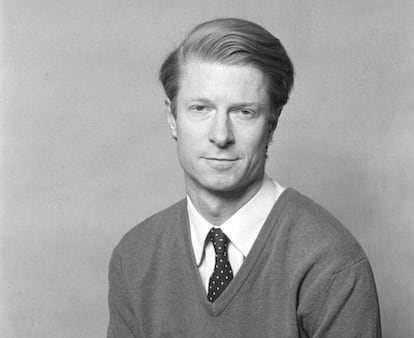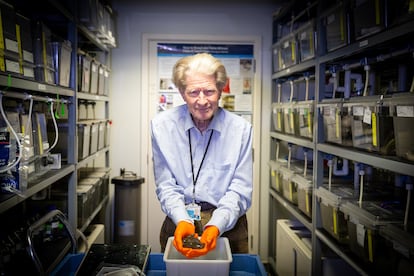John Gurdon, the Nobel Prize winner who made up for lost time, dies

Sometimes you can change the world with humility. “Hello, my name is John Gurdon, and I work with toads.” That was how an extraordinary scientist, discoverer of the non-reversible nature of biological time, inventor of cloning, pioneer of genetic reprogramming, and Nobel Prize winner in Physiology or Medicine , introduced himself. At scientific meetings, his favorite place to be was with the students, who often didn’t know who he was, chatting, asking them about their work, and making them feel important.
The story of John Gurdon, who died this week at the age of 92, is an example of perseverance in the face of adversity and the role of serendipity in our lives. Raised in Surrey, in the south of England, he early developed an interest in nature that led him to collect butterflies and to aspire to be a scientist. This ambition was cut short by the report from his tutor at Eton , where he studied, who evaluated him last in a class of 250 with the prophecy that "in view of his conduct, his interest in being a scientist is, frankly, ridiculous... studying biology would be a waste of time for him and for those who have to teach him." In a very English style of the time, he was sent to study Latin and Greek.
Despite this, with maternal support, which he always remembered, and his own determination, he ended up at Oxford University studying Zoology, on the cusp of what was his interest: entomology. However, there, he suffered another rejection, which, as he said, was perhaps a stroke of luck, since at that time there wasn't much interest in that branch of biology either. And so, stumbling, he met Michael Fishberg, a biologist who had emigrated from Russia, who accepted him as a doctoral student in embryology. As a project, he suggested an experiment to test a fabulous idea that had been floating around laboratories for years: Is biological existence truly irreversible? Perhaps his treatment of the students had something to do with his youthful background.
The discovery of genes and the observation that cells specialize during development starting from the fertilized egg—red blood cells, muscles, neurons, cardiomyocytes—leads to the question of whether, as they specialize, cells lose their initial potential. Is it possible to recover an embryo, or even an adult, from a differentiated cell? That is, is cloning possible? Do cells age? Or, in biological terms, even though they may have different appearances, do cells retain the genes they carry even if they are not used?
Two American scientists, Robert Briggs and Thomas King, to whom Gurdon always paid homage, established the rules of the game with a simple experiment on frogs. By replacing the nucleus of an unfertilized egg with that of a cell from an embryo or a tadpole, they observed whether that nucleus was capable of directing the development of a new frog, a clone of the original. What they discovered was that the nuclei of early embryos were capable of making tadpoles, but that as time passed, the nuclei of later embryos lost this ability. In conclusion, with age and differentiation, cells lost the ability to generate an organism. Cell decisions are not reversible. There is no turning back in biological time.
Science advances through replication, and a negative result can have many causes. At the age of 23, under Fishberg's tutelage and perhaps motivated by his habit of not taking no for an answer, Gurdon began working to replicate Briggs and King's experiments. He switched amphibians, from the frog to the toad Xenopus laevis , and struggled with needles and techniques. After two years, he had his first answer: in 1958, he obtained tadpoles with cells from late-stage embryos. Later, using nuclei from active intestinal cells of a tadpole, he was able to obtain adult toads, which he later showed to be fertile. Over time, he demonstrated the same thing with other cell types. The cell may age, but the information it contains can be recovered. Life is, in principle, reversible.
In Cambridge from 1972, first in the legendary Laboratory of Molecular Biology and then in the Department of Zoology, he established Xenopus as a tool for molecular biology, which was developing at the time, and created a significant intellectual progeny. In 1991, he founded the Wellcome-CRC Institute of Developmental Biology, which would eventually bear his name, and where he explored the molecular rules of developmental biology.

Gurdon's cell reprogramming experiments became central to the transformation of embryology, a descriptive exercise in developmental biology, and an analytical endeavor. They also served as inspiration for several generations of biologists. But outside the field, and outside of science fiction stories about human cloning, which he was never interested in, his work didn't arouse much interest until the birth of Dolly the sheep in 1996. Then the spotlight returned to cloning, and Gurdon's work was cited as a motivation lost in the mists of time. Perhaps it was Dolly 's wool and her name that brought Gurdon's work back into focus, which then, tentatively, emerged from academic circles. At the celebration of his 70th birthday, one of his disciples, reflecting on Dolly 's impact, floated the idea of what would have happened if his first cloned toad had had a name, Kermit, for example.
But recognition came, and in 2012 the Nobel committee recognized her work. What brought the prize wasn't Dolly , but rather the experiments of Japanese scientist Shinya Yamanaka chemically reprogramming adult human cells. Gurdon's extraordinary result with Xenopus was prophetic: there is a route to eternal youth. The offspring of these experiments are still alive.
The 50 years Gurdon spent at Cambridge left behind a significant scientific and teaching career that only the greatest can achieve. He also left behind a collection of anecdotes about a colorful, humane, and very British character. For years, he would go to work in a red Lotus, which he left in the university parking lot and emerge with an antique briefcase containing his secrets. In winter, he rode his bicycle, wrapped up warmly and protected with a wool hat. Always challenging authority and nature with kindness. He loved adventure and, whenever possible, would lose himself in forests, deserts, or mountains, often returning with the reward of his childhood interest: butterflies, from which he occasionally had to be rescued. Gurdon held various administrative and leadership positions at Cambridge University, but he never stopped conducting experiments. It was during the pandemic that he hung up his micromanipulator, microscope, and pipette.
Talking to him was like entering into a Socratic exercise, perhaps derived from his time in classical studies, in which he disarmed you with basic, fundamental questions that laid bare your apparent wisdom.

The many Spaniards who studied and worked at Cambridge—and there were many of us—will remember him offering us his biscuits with a cup of tea and asking us lots of questions about our work in the department or institute cafeteria, always with a mischievous smile that hinted that he knew something more than you, something you perhaps couldn't possibly know. And above all, we remember him sitting in the front row of Friday seminars in one of those old British amphitheaters, listening attentively to talks and, at the end, pausing, asking questions that always illuminated the presentation that preceded them.
John Gurdon has been a beacon for a generation of life scholars who are slowly leaving us, leaving us with a great scientific and technical legacy but bereft of references. Gurdon used to repeat that a scientist should always have questions, that science is driven by questions. This was the mantra of his generation, and it makes some of us wonder what would happen if, in this world of runaway information, where many suggest conducting science without hypotheses, we were able to combine the experience we inherited from them with the possibilities offered by the present. John Gurdon never accepted "no" for an answer, and in his memory, just as we can recover the potential of the cell, perhaps we should recover the art of conducting science with questions that we are leaving behind.
Alfonso Martínez Arias is an ICREA Professor at Pompeu Fabra University and author of the book The Architects of Life (Paidós).
EL PAÍS




